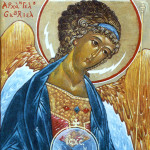Peace at the Last was birthed out of congregational need and experience in a specific time and place: Lake Chelan Lutheran Church in Chelan, Washington, beginning in 2007. A member said to me “Pastor, it feels like people are coming to us to die!” For a long stretch of time our little congregation was facing the deaths of so many. The last of our charter members were lingering at death’s door. At the same time, several younger people—so vibrant and alive—faced chemotherapy and radiation, rising hopes dashed by the relentless diseases that afflicted the body.
Through this time of travail, the ministry of accompaniment was born. Our congregation has continued to be called upon to walk with people who are sick and facing death. People in our congregation and in our larger community have asked us to join them in their journey. Over the years, we have gathered a group of people who go to visit the dying, the sick, and the elderly. One of our people put it well when he said, “I’m completely afraid of being with people who are dying. So I know I have to go to them.”
What we found was that people are reluctant to go into such situations for fear of saying or doing the wrong thing. “Should I talk about death? Do I touch the person I am visiting? Should I pray? What do I pray?”
This honest expression of fear sparked a conversation about why people are afraid to visit nursing homes, hospitals, and sickbeds. What we found was that people are reluctant to go into such situations for fear of saying or doing the wrong thing. “Should I talk about death? Do I touch the person I am visiting? Should I pray? What do I pray?” These are all real issues for people who would like to bear witness to Jesus in the face of mortality, but who do not have what they need to do so.
From this came the idea of creating a liturgy for the visitation of the dying. Of course, pastors have prayers and liturgies at their disposal in pastoral care resources, but we wanted to create something that was accessible to everyone and that was visually beautiful.
For several months our group of eight or nine people met to gather resources that would be appropriate for such a liturgy. Our musician, Rolf Vegdahl, wrote several of the musical pieces in the liturgy. Others found or wrote prayers and blessings. We chose psalms by asking members of the congregation which ones they found most meaningful and reassuring. From start to finish, the liturgy is completely grounded in the experience of our congregation. We believe that truth rooted in a particular congregation can carry truth for the wider church. Indeed, isn’t that what art itself makes clear?
While the liturgy was being compiled over 18 months, Wendy Schramm, the artist, was busy honing her watercolor craft. Lake Chelan Lutheran has a room dedicated to art and Wendy spent hours and hours in the art room and in the natural world around the Chelan area, painting and praying over the liturgy. When we finally had a complete draft of the liturgy, she went to work painting the frame for each piece. Restful and comforting beauty was her goal as she painted. What she found was that not every piece of the liturgy, and, of course, not every moment of dying, is restful. There are stark pieces in the liturgy that she has matched in visual art. Restful, stark, reassuring; it is all beautiful. And, as is proclaimed in the Akathist of Thanksgiving, “All true beauty draws the soul to You.”
I would add that what the liturgy makes clear is that this beauty is an expression of extravagant love!
Beauty is at the heart of the Christian faith. We may discuss whether beauty is necessary or not, affordable or not, but as Alexander Schmemann points out, “Beauty is never ‘necessary,’ ‘functional,’ or ‘useful.’ And when, expecting someone whom we love, we put a beautiful tablecloth on the table and decorate it with candles and flowers, we do all this not out of necessity, but out of love.” I would add that what the liturgy makes clear is that this beauty is an expression of extravagant love!
We who follow Jesus use this and all kinds of beauty to express the love of God to the least among us. It’s a fool’s errand in one sense—to create such a work of beauty for dying people. But I also believe this: if the church dedicated itself to just one thing, to accompanying the dying well, it would not be wrapped up in the anxiety of whether or not the church itself was going to survive. It would have no time for such anxiety. It would be too busy ministering to people who knew where to come to die and to live in the beauty of extravagant love.
From Peace at the Last by Paul Palumbo, copyright © 2016 Augsburg Fortress. Reproduced by permission. No further reproduction allowed without the written permission of the publisher. Contact copyright@1517.media.


